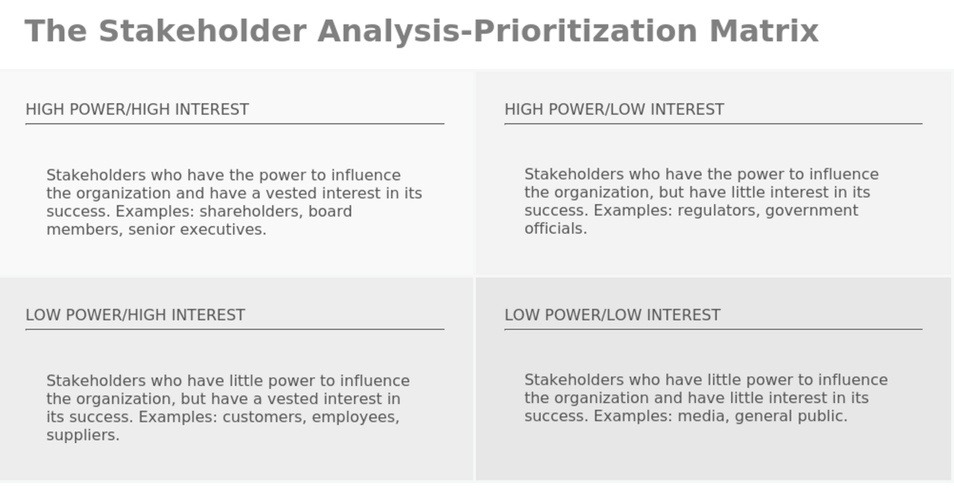Navigating Success in Tech: The Art of Stakeholder Management
Effective stakeholder management is an essential skill in the tech industry and beyond. In this blog post, we'll unravel the intricacies of stakeholder management in the tech sector—what it is, why it's crucial, and how to excel at it.

Effective stakeholder management is an essential skill in the tech industry and beyond. In this blog post, we'll unravel the intricacies of stakeholder management in the tech sector—what it is, why it's crucial, and how to excel at it.
What is Stakeholder Management, and Why is it Important?
Defining “Stakeholder”
Before delving into stakeholder management, it's essential to grasp the concept of a stakeholder. In the context of the tech industry, stakeholders are individuals or groups who have a vested interest in the success, outcome, or impact of a project, product, or organization. These can encompass a wide range of entities, including customers, employees, investors, partners, regulatory bodies, and sometimes even the wider community.
Understanding Stakeholder Management
Stakeholder management, then, is the strategic process of identifying, engaging with, and satisfying these stakeholders. It's about navigating the complex web of relationships within and around a tech project, ensuring that the interests and expectations of all involved parties are considered and managed effectively.
And Why Stakeholder Management is Relevant in Tech
Stakeholder management plays a pivotal role in the day-to-day workstreams of product managers, engineering managers, and product designers and other roles in the tech industry. Each of these roles interacts with a diverse set of partners, and effectively managing these relationships is essential for success.
- Product Managers will often consider customers/end users, development teams, internal executives, marketing and sales teams, and third party providers amongst their stakeholders. Across all of these, they will have to collaborate on user research, feedback and analysis, setting a common vision, defining business cases, and demonstrating ROI.
- Product Designers are deeply involved in understanding user needs and preferences as the main stakeholder in their work. To effectively serve the end user, they will work with product managers, engineers, and other cross-functional teams in the design process. Additionally, development teams and accessibility and compliance teams will ensure that design concepts are implemented accurately and effectively while also meeting regulatory requirements.
- Engineering Managers also work with development, Product Managers, and internal executives to establish resource requirements and realistic project scopes. In concert with these teams, they’ll often collaborate with QA and testing teams to ensure product quality, and operation teams to enable post-launch monitoring and support.
These are just a few examples of roles commonly engaging in stakeholder management.
What Does Stakeholder Management Look Like?
It might be helpful consider the levels of stakeholder management around “good,” “better,” and “best.” Just like any other project or relationship, there will be different levels of effort and engagement that likewise contribute to effective relationships.
- “Good” management would simply translate to “meets expectations.” Everyone knew what was going on throughout the project period, and the result was delivered on time and as planned.
- “Better” stakeholder management is focused more on the process: did you anticipate needs and challenges, and proactively address them? This would minimize stress and lack of clarity ahead of project delivery.
- Finally, “best” case scenario in managing stakeholders might entail establishing an ecosystem amongst all partners in which each partner feels like they contributed to — and benefitted from — the outcome. This ensures strong, collaborative relationships that can grow to take on new projects, or longer-term deliverables with confidence and trust.
Kirk Fernandes, Founder of Merit, says, “Stakeholder management, from start-ups to big companies, is really about empathy.
Start by making an effort to understand what a person's job is, and what their goals are. It becomes a lot easier to collaborate if you understand a person or a team's incentives. Early in my career I made the mistake of expecting other people to want to achieve my goals. Instead, by identifying common goals and understanding alignment, constraints, and pressures, it becomes a lot easier to get things done.”
Foundational Elements to Stakeholder Management
First and foremost, remember that it is important to cultivate and nurture stakeholder relationships before you need them. Getting to know colleagues on internal teams, acknowledging common interest and industry with external partners, and generally establishing one’s self (or one’s team) as a resource and a thought leader is a great way to establish common ground. When projects are assigned or become available, your relationships with collaborators professionally precede their role as stakeholders, enabling a more trusting and open process from the beginning.
While having a pre-existing relationship with stakeholders is not always possible, these steps will get you on track towards productive and positive stakeholder management in any scenario:
- Preferred Methods of Engagement and Communication: Effective stakeholder management begins with understanding the diverse preferences of your stakeholders. Some may prefer regular face-to-face meetings, while others may favor asynchronous communication via email or messaging platforms like Slack. Recognize these differences and adapt your communication methods accordingly.
- Define Expectations: From project initiation, establish clear, realistic expectations with stakeholders. Be transparent about objectives, timelines, potential risks, and the roles each stakeholder will play. Clarity at the outset builds trust and reduces misunderstandings later on.
- Pay Attention to Stakeholder Mood: Stakeholders are invested not just in the final outcome but also in the process. Monitor their sentiments and concerns throughout the project's lifecycle. Address issues proactively — by asking questions or regularly sharing surveys — demonstrating your commitment to their interests.
Skills for Great Stakeholder Management
Effective stakeholder management hinges on a set of soft skills such as communication, empathy, negotiation, and conflict resolution. Sharpening these skills not only enhances your ability to manage stakeholders but also boosts your career prospects in an industry that values collaboration and teamwork. Check out this recent blog post from Merit for additional insight into soft skills relevant for tech roles.
Additionally, embracing a transformational leadership style can be especially valuable in stakeholder management. This approach emphasizes inspiring and motivating team members and stakeholders by painting a compelling vision of the future. It can unite your team and stakeholders behind a common mission, fostering a culture of cooperation and innovation. More on transformational leadership is available here.
Inside the Stakeholder Management Process
- Stakeholder Mapping: Kickstart your stakeholder management journey by comprehensively identifying all relevant stakeholders. Create a stakeholder map that assesses their level of influence and interest in the project. This mapping exercise enables you to prioritize your efforts and allocate resources wisely.
- Stakeholder Prioritization: Not all stakeholders wield the same level of impact on your project's success. Focus your attention and resources on those stakeholders with the highest influence and interest. By doing so, you maximize your effectiveness in managing the stakeholders that matter most. Check out the Matrix below from the Priority Matrix blog as an example of how to do this.

- Internal vs. External Stakeholders: Distinguish between internal stakeholders (such as team members and executives) and external stakeholders (including end users, regulators, and partners). Recognize that each group may require a unique approach to engagement and management, considering their specific needs, interests, and expectations.
- Up vs. Down vs. Parallel: Stakeholder relationships can take different forms. Some are hierarchical, with stakeholders above or below you in the organizational structure, while others are parallel, involving peers or partners. Tailor your approach to suit the nature of each relationship.
How to Nurture Your Stakeholder Relationships
- Building Relationships Before Needing to Use Them: Don't wait until you need a favor or support from stakeholders to establish a relationship. Cultivate connections early, showing genuine interest in their concerns and objectives.
- Maintain Contact Even Post-Project: Effective stakeholder management doesn't end with the project's conclusion. Stay engaged with stakeholders and keep them informed about significant changes or developments within your company or team. This ongoing relationship-building can open doors to future collaborations and opportunities.
- Seek New Opportunities to Work with Them: If a stakeholder has experienced success and satisfaction in previous collaborations, actively explore new opportunities to work together. Consistently delivering on promises and building a track record of successful projects can solidify your relationships and elevate your reputation.
- Celebrate Their Achievements/Successes: When relevant, celebrate your stakeholders' achievements or milestones. Recognizing and acknowledging their contributions not only strengthens your relationship but also fosters a positive and mutually beneficial partnership. A little appreciation can go a long way in ensuring ongoing support and collaboration.
Stakeholder management is about more than just managing expectations; it's about building enduring relationships that fuel innovation, facilitate collaboration, and drive projects to success.
Connect with product managers, engineers, and more on Merit to learn more about effective Stakeholder Management and other relevant skills in tech:
